The #1 tip for creating a mobile-responsive HVAC website that wows visitors is to prioritize fast-loading, user-friendly design with clear navigation and easy-to-click call-to-action buttons. Having a mobile-responsive website is more important than ever. With a significant portion of web traffic coming from mobile devices, ensuring your website looks great and functions well on all screen sizes is crucial. This guide will walk you through the essential steps to create a mobile-responsive website that will leave a lasting impression on your visitors.
Click on each corresponding link to jump ahead:
- Understand the Importance of Mobile-Responsiveness
- Use a Mobile-First Design Approach
- Choose the Right Framework
- Optimize Images for Mobile
- Implement Responsive Typography
- Test on Multiple Devices
- Prioritize Performance
- Use Media Queries Effectively
- Keep Navigation Simple
- Monitor and Improve
- How to make a Website Mobile Responsive
- Best HVAC Website Examples
- Best HVAC Website Platform

Source: Dreamstime.com
If you are an HVAC company looking to redesign your website to meet the ever-evolving need, contact Profitworks today!
1) Understand the Importance of Mobile-Responsiveness
The Secret to be Mobile Friendly in 10 Minutes | Truly Responsive Web Design
HVAC customers often search for heating and cooling services on their smartphones when they need urgent repairs or maintenance. A mobile-responsive website ensures that potential customers can easily navigate your site, read service details, and contact your business without frustration. Beyond user experience, Google prioritizes mobile-friendly sites in search rankings, making responsiveness essential for visibility and lead generation.
2) Use a Mobile-First Design Approach

Source: Paragon
Since many HVAC customers browse on mobile devices, designing for smaller screens first ensures your most important content—such as service areas, emergency contact numbers, and booking options—is front and center. A clean, simple layout with easy-to-click buttons will improve usability. As the design expands to the desktop, additional elements like service videos or customer testimonials can be incorporated for enhanced engagement. Working with a web design company can help ensure this process occurs smoothly.
3) Choose the Right Framework
Learn Bootstrap in less than 20 minutes - Responsive Website Tutorial
Using a responsive framework like Bootstrap or Foundation can streamline the development process for your HVAC website. These frameworks provide flexible grid systems and responsive components that automatically adjust to different screen sizes, ensuring service descriptions, pricing, and appointment booking forms display correctly on all devices.
4) Optimize Images for Mobile
Optimize Images For Your Website ... FREE
Before-and-after photos, team images, and service pictures are crucial for HVAC websites, but large, unoptimized images can slow load times. Optimize images by compressing them and using next-gen formats like WebP to maintain quality while improving speed. Faster load times mean potential customers can view your site without delays, reducing bounce rates.
5) Implement Responsive Typography
Simple solutions to responsive typography
HVAC customers need clear, easy-to-read information on mobile devices. Use responsive typography to ensure headlines, service descriptions, and contact details are legible on any screen. Relative units like ems or percentages for font sizes help text scale smoothly. Additionally, using SVGs for logos and icons ensures crisp visuals on high-resolution displays.
6) Test on Multiple Devices
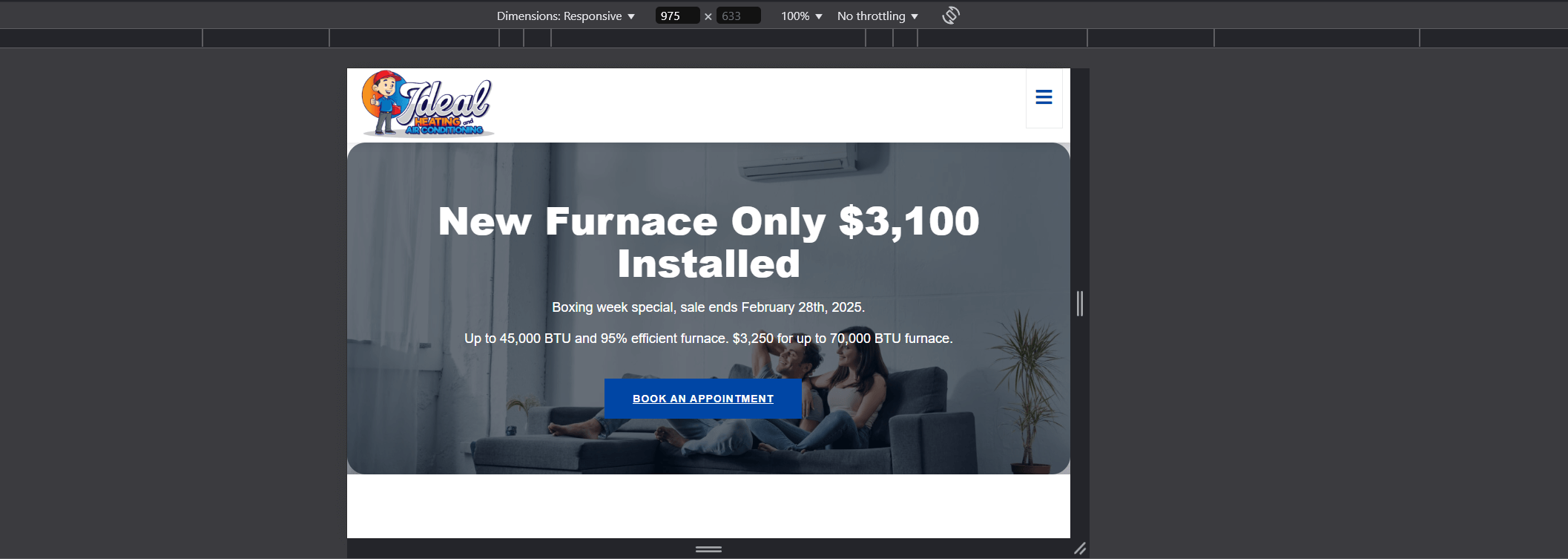
Source: Ideal Heating
Your HVAC website should function seamlessly across smartphones, tablets, and desktops. Use testing tools like Google’s Mobile-Friendly Test or BrowserStack to check responsiveness across different devices. Additionally, manually test your website on both iOS and Android smartphones to ensure easy navigation, smooth scrolling, and quick access to key services.
7) Prioritize Performance
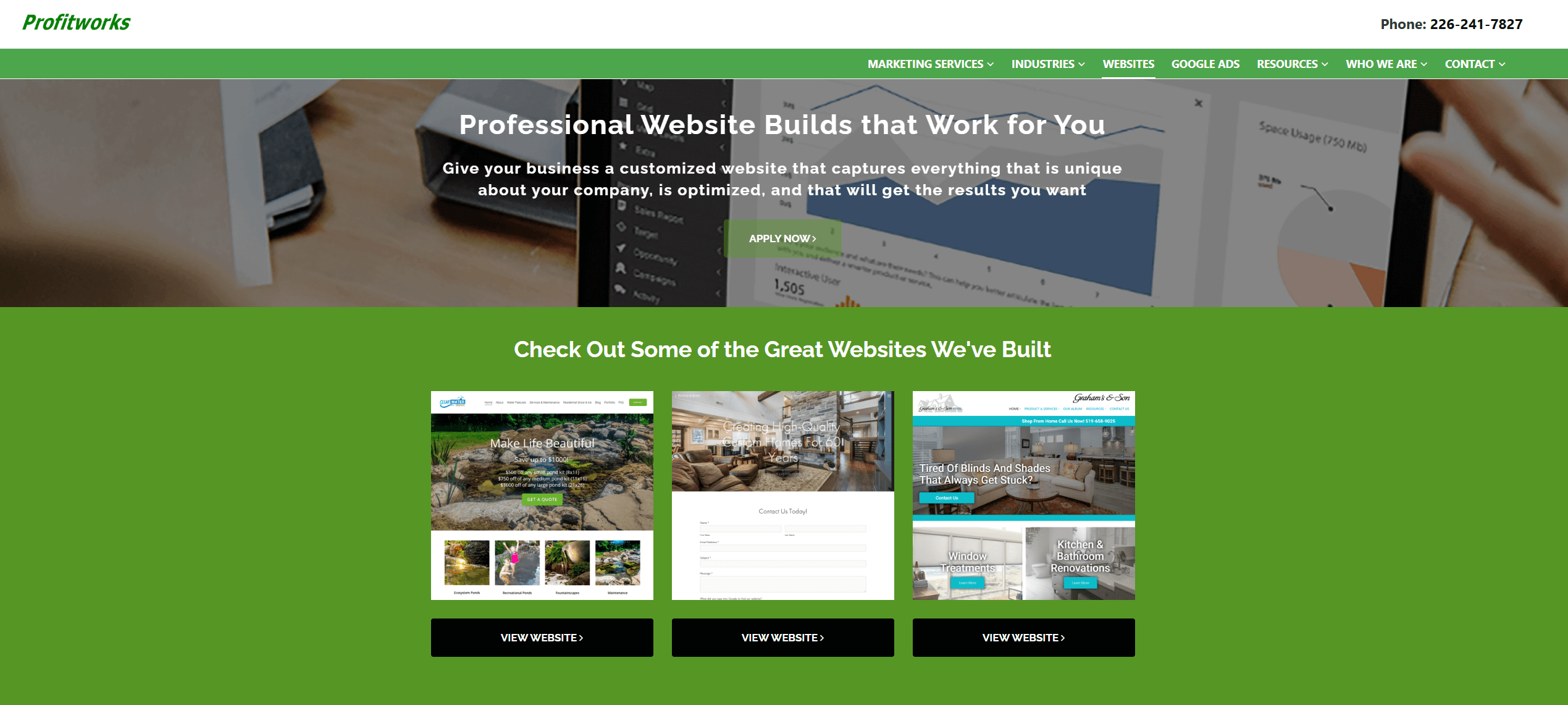
Source: Profitworks
A slow website can cost you leads. Optimize performance by compressing files, reducing HTTP requests, and enabling browser caching. Google PageSpeed Insights can provide specific recommendations to enhance speed. Since many HVAC customers need fast service, ensuring quick load times can mean the difference between securing a job or losing a potential customer. The Digital Marketing and Web Design company Profitworks can help you with this process!
8) Use Media Queries Effectively

Source: W3Schools
Media queries allow you to fine-tune your HVAC website’s design for different screen sizes. Define breakpoints to adjust font sizes, padding, and image scaling for a seamless experience. For example, ensure that phone numbers and contact buttons remain prominent on smaller screens, making it easy for customers to request service with a single tap.
9) Keep Navigation Simple

Source: Ideal Heating
An HVAC website should be easy to navigate, especially for customers in need of emergency service. Use a simple, mobile-friendly menu with clear labels like “Emergency HVAC Services,” “AC Repair,” and “Schedule an Appointment.” Sticky navigation bars or collapsible menus help users find what they need quickly without excessive scrolling.
10) Monitor and Improve
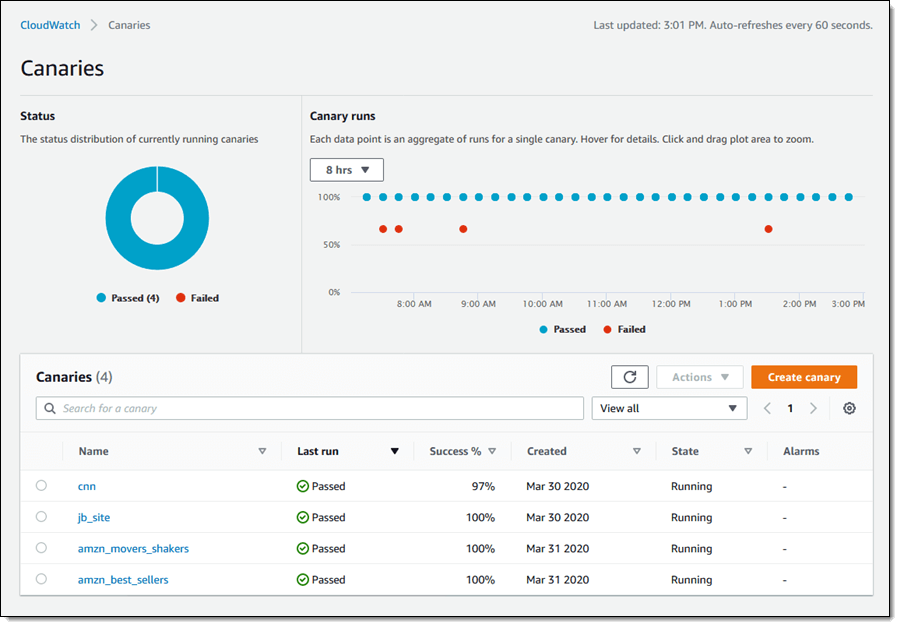
Source: AWS
Creating a mobile-responsive HVAC website isn’t a one-time task—it requires ongoing optimization. Use Google Analytics to track mobile visitor behaviour, identify pages with high bounce rates, and make improvements. Regularly update content, test load speeds, and ensure that contact forms and booking features remain functional.
11) How to make a Website Mobile Responsive
Master Media Queries And Responsive CSS Web Design Like a Chameleon!
Creating a mobile-responsive HVAC website requires a combination of design, development, and performance optimization to ensure seamless usability across all devices. Here’s how to achieve it:
- Use a Mobile-First Design Approach – Start with a layout that prioritizes essential content like service pages, emergency contact information, and a booking form. Then, scale up for larger screens by adding additional elements like customer reviews and blog content.
- Leverage Responsive Frameworks – Tools like Bootstrap or Foundation simplify the process with pre-built responsive grids and components that automatically adjust to different screen sizes.
- Optimize Images and Media – HVAC service images, technician photos, and before-and-after visuals should be compressed and converted to WebP format to maintain quality while improving load times.
- Ensure Touch-Friendly Navigation – Large buttons, collapsible menus, and easily tappable phone numbers make it simple for mobile users to request a quote or schedule service.
- Test Across Multiple Devices – Use tools like Google’s Mobile-Friendly Test, BrowserStack, or actual smartphones to check your site’s responsiveness and make necessary adjustments.
- Improve Load Speed – Minimize heavy scripts, enable browser caching, and use a content delivery network (CDN) to reduce loading times and keep visitors engaged.
By following these steps, you can create an HVAC website that’s easy to navigate, fast-loading, and fully functional across all mobile devices.
12) Best HVAC Website Examples
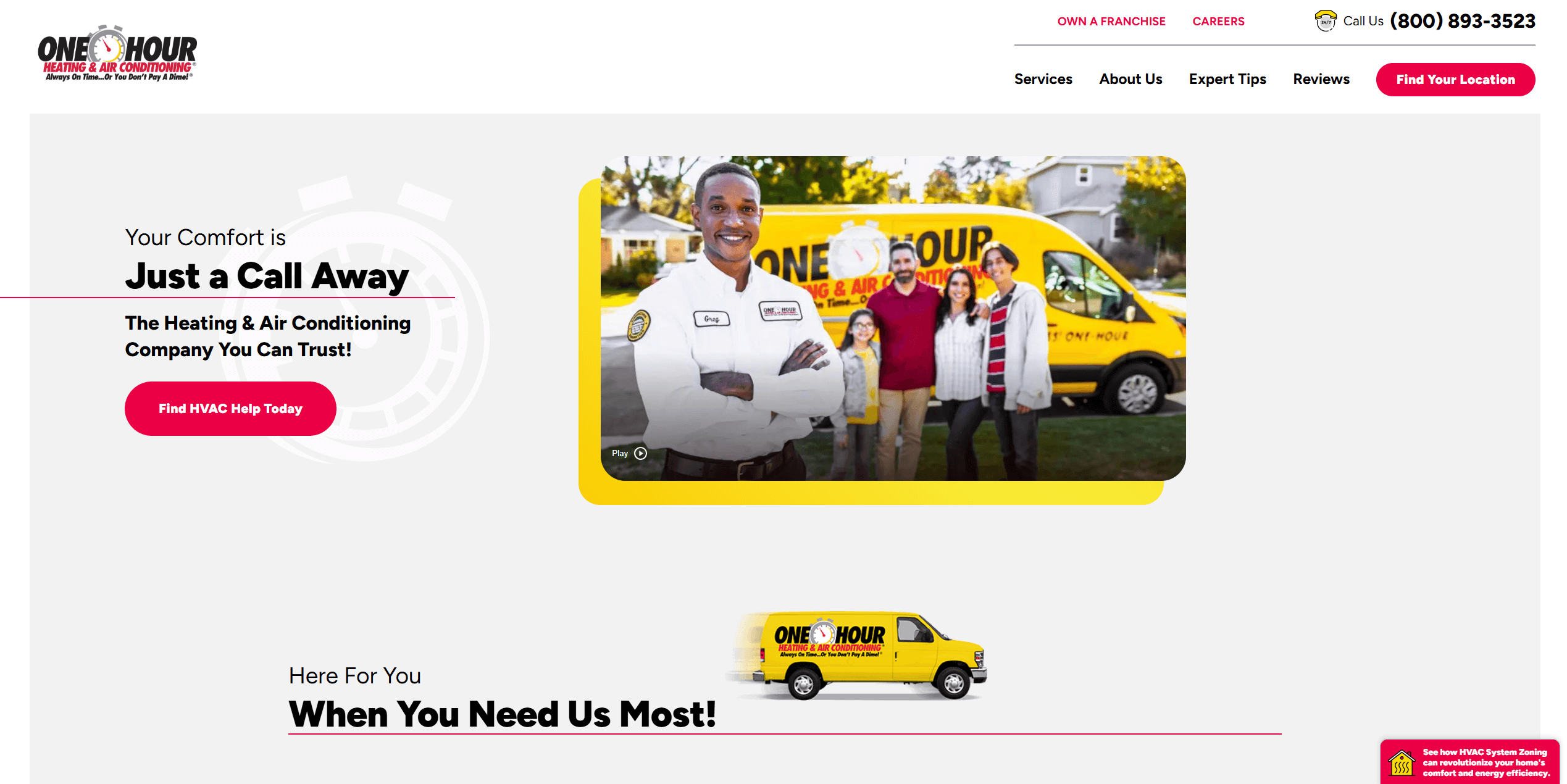
Source: One Hour Heating
If you’re looking for inspiration to design an HVAC website that converts visitors into leads, here are some of the best examples of mobile-responsive HVAC websites:
- One Hour Heating & Air Conditioning – This site features a clean, mobile-friendly layout with a bold call-to-action button, ensuring customers can quickly schedule a service.
- Service Experts Heating & Air Conditioning – With intuitive navigation, a well-organized service menu, and fast-loading pages, this site makes it easy for users to find what they need.
- ARS/Rescue Rooter – This website uses location-based features, making it effortless for customers to find HVAC services near them.
- Goettl Air Conditioning & Plumbing – The site highlights trust-building elements like customer testimonials, financing options, and an easy-to-use booking system.
- Petro Home Services – A prime example of a website that balances visuals and functionality, Petro’s site features engaging images, educational content, and a well-placed contact form.
Each of these websites prioritizes mobile responsiveness, fast loading speeds, and a strong call to action—key elements that every HVAC website should incorporate. Also, check out the list of websites Profitworks has built for customers!
13) Best HVAC Website Platform
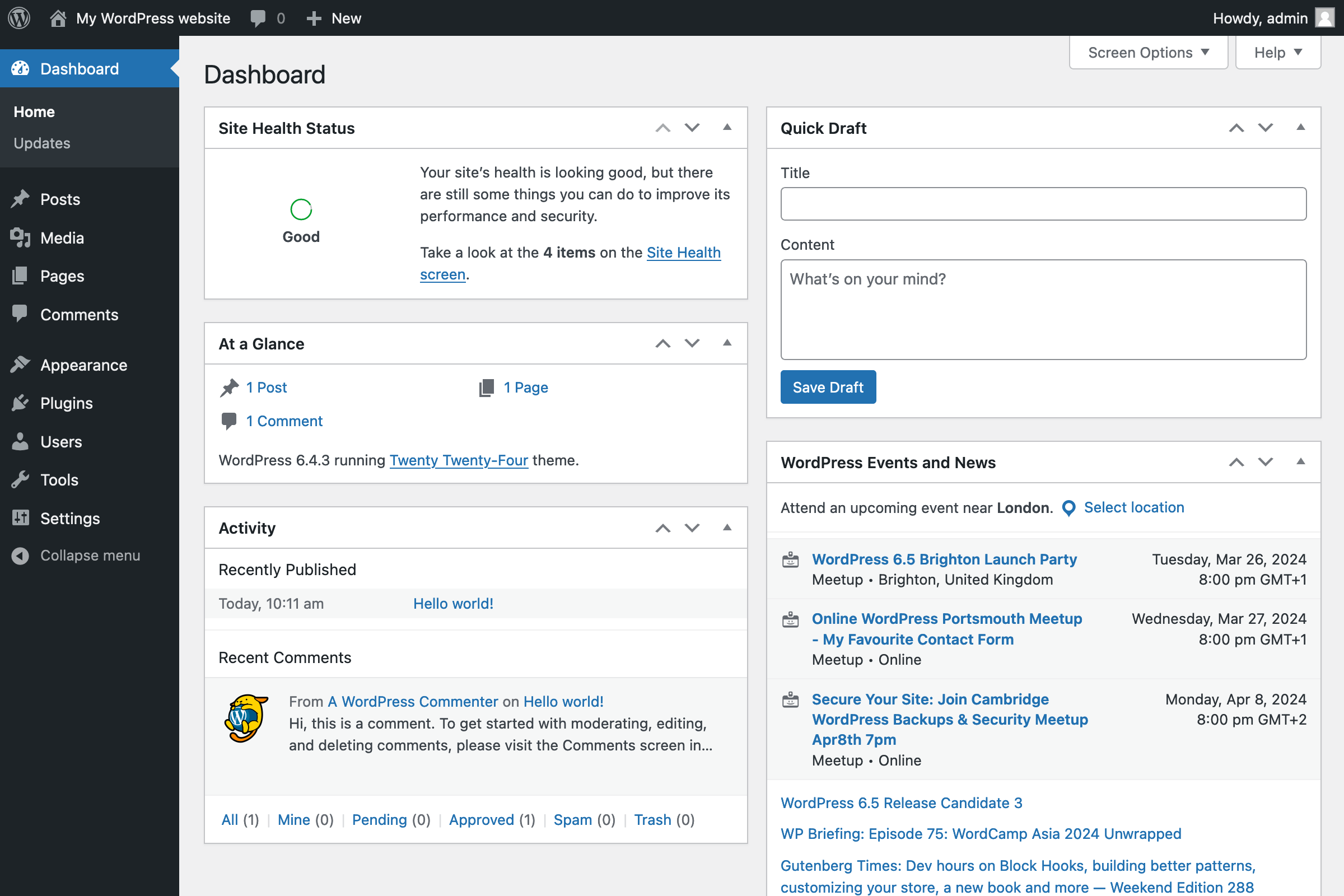
Source: Wordpress
Choosing the right platform for your HVAC website is crucial for ensuring smooth performance, easy maintenance, and mobile responsiveness. Here are the top platforms to consider:
- WordPress – A highly customizable platform that allows for full control over design and SEO optimization. Using themes like Divi or Elementor, HVAC businesses can create visually appealing, mobile-friendly websites.
- Wix – A beginner-friendly platform with drag-and-drop functionality, making it easy to build a professional HVAC website without coding. The built-in mobile editor ensures responsive design.
- Squarespace – Known for its sleek, high-quality designs, Squarespace is great for HVAC businesses that want a polished, modern look with built-in mobile optimization.
- Webflow – Offers advanced design flexibility with a responsive-first approach, ideal for HVAC companies that want a custom look without relying on templates.
- Shopify (for HVAC product sales) – If your HVAC business sells filters, thermostats, or other HVAC-related products, Shopify is a great platform for e-commerce with built-in mobile responsiveness.
For most HVAC companies, WordPress is the best option due to its SEO capabilities, flexibility, and wide range of plugins that enhance mobile performance and lead generation. However, Wix and Squarespace offer great alternatives for businesses that prefer an easier, all-in-one website-building experience.
